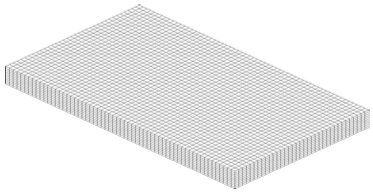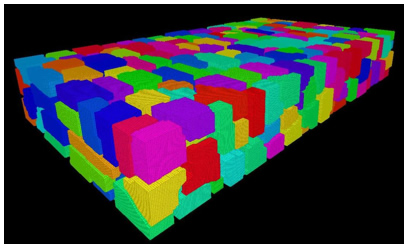PEER Analysis Platform for Demand Simulation - 4102005
| Project Title—ID Number | PEER Analysis Platform for Demand Simulation - 4102005 |
| Start/End Dates | 10/1/05 – 9/30/06 |
| Funding Source | PEER-CA-General Fund |
| Project Leader (boldface) and Other Team Members | Gregory L. Fenves (UCB/F), Frank McKenna (UCB/PD), George Petropoulis (UCB/GS) |
Project goals and objectives
The objectives of this project are to design, develop, implement, and utilize OpenSees (the Open System for Earthquake Engineering Simulation), a software framework for simulation of structural and geotechnical systems. The open-source software is an important enabling technology within PEER because it allows integration of the results of research in structural performance modeling, geotechnical modeling of soils and foundations, computational methods, and advanced information technologies, such as databases and visualization. The objective of this project is to continue the development of the simulation technology. A major thrust is adapting the recent models developed for OpenSees for parallel and distributed computing. This will enable larger problems to be analyzed. This project also provides the user and developer support for many other PEER projects that are utilizing OpenSees in their research. We continue to hold workshops for both users and developers, and meet regularly with the PEER participants involved with OpenSees to assist in their research and projects.
Role of this project in supporting PEER's mission (vision)
Simulation systems for engineering demand parameters (EDP) and also damage measures (DM) is central to PEER's PBEE methodology. OpenSees is the primary software used for conducting advanced simulations of structural and geotechnical systems. It serves as means of communication within (and outside) PEER by allowing researchers access to a wide variety of community-developed models. With the advent of NEES, this is extended to community data and computational resources. The software is critical to the conduct of the PEER benchmark studies, and the lessons-learned in the testbed projects have been being incorporated into the models and simulation methods.
Methodology employed
The project has three major components. The first component is the continued development and maintenance of the software architecture. OpenSees is designed and implemented as an object- oriented framework. This means that it is a, now large, set of modules (called classes) that represent the data and operators on data needed for modeling and simulation. The classes are then used to develop simulation applications in a flexible and extensible manner. The extensions for parallel and distributed computing are included in this component, using the underlying distributed memory model in OpenSees.
The second component of the project involves graduate student research to extend and improve the framework. The research is a combination of engineering and computer science topics. In Year 9, we are continuing work on parameterization of models and extending the framework for multi-physics. On the latter, a graduate student has been developing OpenSees applications for large-scale computation of ground motion simulation. The goal will be to analyze "soil islands" with building and foundation systems to represent site response effects, soil-foundation-structure interaction, and building response. This is important because the local site response and interaction effects are known to have a large effect on engineering demand parameters and ultimately performance of buildings and also bridges.
The third component of the project is providing support for OpenSees users and developers, primarily working on PEER projects. This is an important investment in resources so that PEER researchers can effectively utilized and extend OpenSees. Also included in this component is continual updating of the documentation and holding workshops.
Brief Description of previous year's achievements, with emphasis on accomplishments during last year (Year 8)
In Year 8, continuous improvement in the modeling and computational capability of OpenSees has been pursued. A number of new models developed by PEER researchers have been incorporated into the base software, including concrete models, a reinforcing steel model, and new solid elements. There is ongoing effort to document, validate, and distribute the many contributions.
In the high-performance computing arena, considerable progress has been made in optimizing the software on computing clusters. For example, we are working with SDSC on an implementation on the DataStar for parallel computation of ground motion in a soil island. A new explicit solver was developed in OpenSees, which is very scalable. As one example, shown below is an OpenSees mesh of a 1200m x 700m x 200m layered soil region with 5.25 million elements (16 million DOF). The ground motion simulation is run on 400 processors using the DRM method for defining the boundary conditions on all sides. The computation is accurate up to about 4 Hz. The top figure is the mesh, and the second figure uses coloring to show the distribution of the mesh to the 400 processors. Total throughput is over 60Gflops. We are currently working on extending the analysis to include building and foundation models.


Other similar work being conducted within and outside PEER and how this project differs
Although there has been much good research on modeling and simulation of structural and geotechnical systems, OpenSees continues to be a unique integrative project that integrates the results of the research into a common software framework. The flexible, object-oriented design makes this unique aspect possible.
This project is central to nearly all the projects in Thrust Area 4, and it is a critical enabling technology used by many other projects in the buildings and bridges thrust areas. OpenSees incorporates software deliverables from other projects involved with development, provides software interfaces for projects that add capability, or is the simulation tool used by other projects. OpenSees will be the simulation engine for the planned modules implemented the PBEE methodology.
Describe any instances where you are aware that your results have been used in industry
We have a number of users in industry and are starting to field inquires about licensing OpenSees. The software is widely used around the world by researchers as evidenced by Google hits and the number of OpenSees websites, particularly in Asia.
Expected milestones & deliverables
- Continued development and support of the base software.
- Integrate developments in other PEER projects into OpenSees.
- Continued validation of models.
- Development of implicit-explicit solver for soil-structure-foundation-interaction on parallel computers.
Member company benefits
Access to advanced modeling and simulation software and expertise on how to use it.
Back to Funded Project Archive main page

